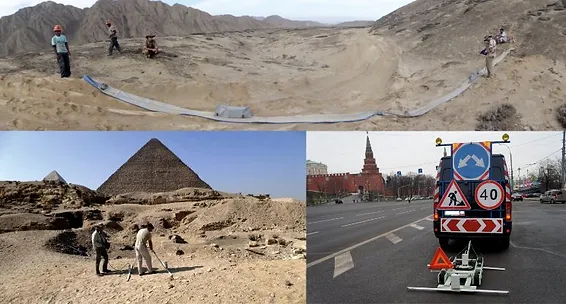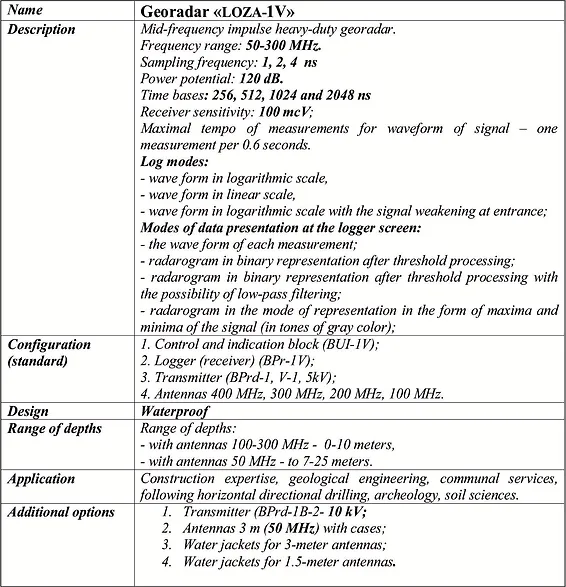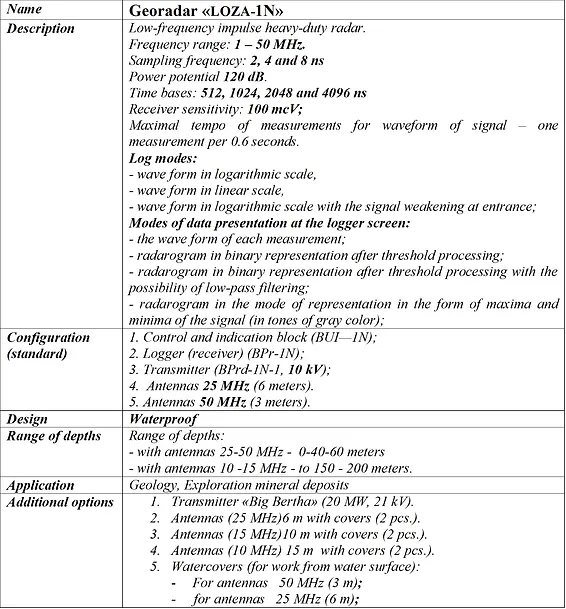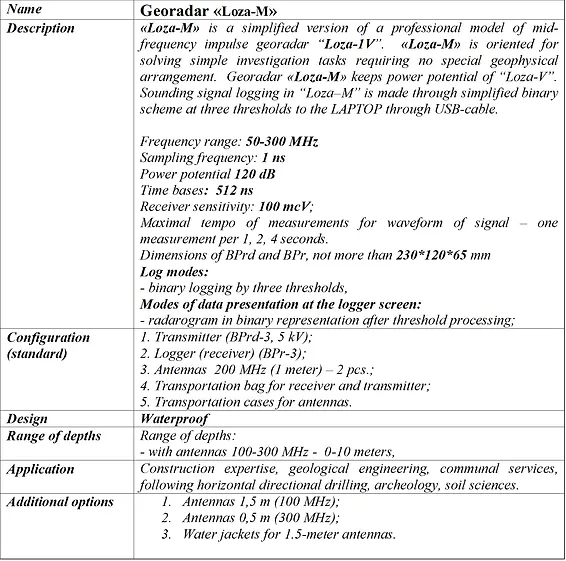
Still, there still is a number of variations (V, V1, V2, N, N1, М) that differ in measuring modes. List the complete range of products, configurations and applications.
Loza georadar has two main modifications having fundamental differences:
- «Loza-V» – mid-frequency georadar, receiver frequency band is 50-300 MHz.
- «Loza-N» – low-frequency georadar, receiver frequency band is 1 – 50 MHz.
Versions V, V1 and V2 (as well as N, N1 and N2) have unprincipled differences and reflect the stages of development of our GPR during the last 16 years:
- Model «V, N» (2002-2004) provided registering in binary and wave mode (in logarithmic scale). Georadar had time bases of 256, 512, 1024 ns.
- To the model «V1, N2» (2004-2006) time bases of 2048 ns were added (for Loza-1N – time bases of 4096 ns).
- To the model «V2, N2» (2006-2014) additional measuring modes were added: – waveform in linear scale, – waveform in logarithmic scale with the possibility to weaken signal at inputting “LOGARITHMIC 1” parameters.
This model provides signal pre-processing and demonstrating picture on the display in real time. Pre-processing meant possibility of LF filtration (smoothing) at axes T (depth) and X (length). Filtration results are shown on the display in signal lows (black lines) and peaks (white lines) mode. Protocol of each measure has information on the time of measuring accurate to the second to link sounding data with GPS recordings.
In recent years, we have stopped changing the model indices, although the modernization of the device continues. A new generation of the device with the index “4” has a built-in GPS chip, and the coordinates are recorded in a file for each measurement.
There also were so-called “exotic” modifications V and N, for example, Loza-V was created, which was able to make 50 measurements per second in binary mode, another Loza-V could work with a cable between Control Block and receiver having length of 25 meters (the standard cable length is 1.6 meters).
The history of the Loza-M model is slightly different. The M version is the first model we released serially (1999 – 2004). The device made it possible to record the reflected signals only in binary form along three thresholds. The sweep is 256 and 512 ns, the transmitter is 5 kV (~ 1 MW), the antennas are 1 meter (200 MHz) and 1.5 meters (100 MHz). After 2004, the release of the instruments of this model was discontinued. In 2012, there was a demand again in an inexpensive georadar, the release of Loza-M was resumed as a low-cost georadar. The Loza-M sample of 2016 registers a signal to the laptop. Registration is binary in three thresholds. Scanning 512 nsec. The rate is 30 measurements per second. The set includes antennas 0.5 m, 1 m and 1.5 m. The completeness of each model can vary, depending on the tasks that the customer plans to solve.
Configuration of each model may be changed depending on the tasks required to be solved by the customer. In our commercial offers we show base configuration and additional options:
1. GPR Loza-1

2. GPR Loza-1N

3. Loza-M

The enumeration of all devices and their specifications is an attempt to show that GPR Loza are not single devices, in the hands of the manufacturer. GPR Loza widely used not only in the territory of Russia, Ukraine, Kazakhstan and so on., but is also widely used today in Western Europe (Italy, Spain, Czech Republic…) , Africa, South America (Peru, Chile) the Middle East (Iran, Oman, Egypt, Israel…), Southeast Asia and Australia. Just recently, in the US (where the device has passed the necessary verification and certification).